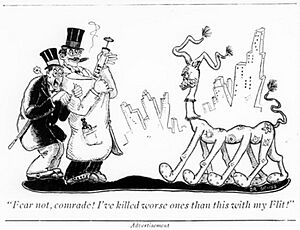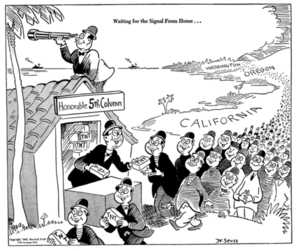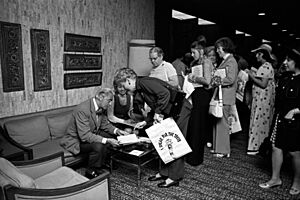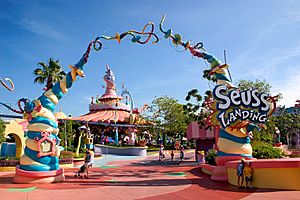Dr. Seuss facts for kids
Quick facts for kids
Dr. Seuss
|
|
|---|---|
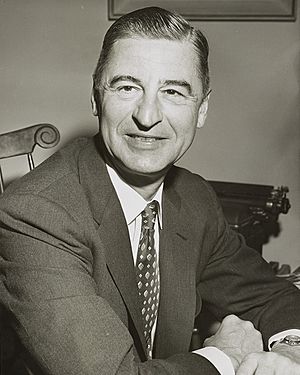
Dr. Seuss in 1957
|
|
| Born | Theodor Seuss Geisel March 2, 1904 Springfield, Massachusetts, U.S. |
| Died | September 24, 1991 (aged 87) San Diego, California, U.S. |
| Pen name |
|
| Occupation |
|
| Education | |
| Genre | Children's literature |
| Years active | 1921–1991 |
| Spouse | |
| Signature | |
 |
|
Theodor Seuss Geisel (March 2, 1904 – September 24, 1991) was a famous American writer, artist, and animator. He is best known by his pen name, Dr. Seuss. He wrote and illustrated more than 60 books for children. His books are known for their funny rhymes and imaginative characters. They have sold over 600 million copies all over the world and have been translated into more than 20 languages.
Some of his most popular books are The Cat in the Hat, Green Eggs and Ham, and How the Grinch Stole Christmas!. Before he became a famous book author, he worked as a cartoonist for magazines and drew advertisements. During World War II, he made films for the United States Army. His birthday, March 2, is celebrated every year as National Read Across America Day to encourage children to read.
Contents
Biography of Dr. Seuss
Early Years in Springfield
Theodor Seuss Geisel was born in Springfield, Massachusetts. His father, Theodor Robert Geisel, managed a family brewery and later looked after the public parks in the city. His mother was Henrietta Seuss Geisel. The family was of German heritage.
Geisel grew up near Mulberry Street, which he later made famous in his very first children's book. As a child, he sometimes faced bullying because of his German background during World War I. He was raised in the Lutheran faith.
College and the Name Dr. Seuss
Geisel went to college at Dartmouth College and graduated in 1925. While there, he wrote for the school's humor magazine called the Dartmouth Jack-O-Lantern. He eventually became the editor-in-chief.
One day, Geisel and his friends were caught breaking a school rule regarding parties. As a punishment, the school dean told him he could no longer work on the magazine. To keep writing without getting caught by the administration, Geisel started signing his work with his middle name, "Seuss". This was the beginning of his famous pen name.
After Dartmouth, he went to Lincoln College, Oxford in England. He planned to become an English teacher. However, he met a fellow student named Helen Palmer. She saw his drawings of strange animals and told him he should be an artist instead of a teacher. Geisel decided to follow her advice. He left Oxford without a degree and returned to the United States.
Career as an Author and Illustrator
First Books and Advertising
In 1927, Geisel moved to New York City. He married Helen Palmer that same year. He started working for a humor magazine called Judge.
He soon became famous for drawing advertisements for a bug spray called Flit. His catchphrase for the ads, "Quick, Henry, the Flit!", became very popular. He drew ads for many other companies like Standard Oil and the Ford Motor Company. This work earned him enough money to travel to many different countries.
In 1936, while traveling on a ship, the rhythm of the ship's engine inspired a poem. This poem became his first children's book, And to Think That I Saw It on Mulberry Street. Geisel said the book was rejected by more than 20 publishers who did not want to print it. Finally, a friend helped him get it published in 1937. He wrote four more books before World War II began.
Work During World War II
When World War II started, Geisel wanted to help. He drew many political cartoons for a newspaper called PM. His cartoons supported the war effort and criticized leaders like Adolf Hitler.
In 1943, he joined the United States Army. He served as a captain in the animation department. He wrote and produced training films for soldiers. One of his projects, Design for Death, later won an Academy Award for Best Documentary Feature.
Famous Dr. Seuss Books
After the war, Geisel moved to La Jolla, California, and went back to writing children's books. This was his most successful time. He wrote favorites like If I Ran the Zoo (1950) and Horton Hears a Who! (1954).
The Cat in the Hat and Beginner Books
In 1954, a report said that children were not learning to read well because their books were boring. A publisher asked Geisel to write a book that was exciting but used only a small list of simple words.
Geisel accepted the challenge and wrote The Cat in the Hat (1957). He used only 236 different words. The book was a huge hit and helped many children learn to read. Following this success, he helped create a series called Beginner Books.
Later, someone bet Geisel $50 that he could not write a book using only 50 different words. Geisel won the bet by writing Green Eggs and Ham (1960). It became one of the best-selling children's books in history.
Writing Style and Artwork
Rhymes and Rhythms
Dr. Seuss is famous for his rhymes. He often wrote in a poetic meter called anapestic tetrameter. This rhythm sounds like a galloping horse (da-da-DUM, da-da-DUM). This catchy rhythm makes his books fun to read aloud and helps children guess the next word.
Unique Illustrations
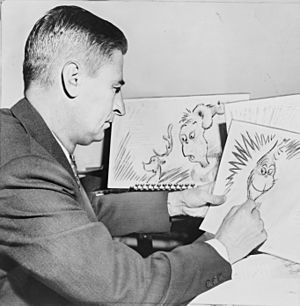
Geisel's drawings are very unique. He rarely drew straight lines. His buildings, machines, and staircases are often curved, droopy, or rounded. He enjoyed drawing made-up animals and strange contraptions.
For example, in The Sneetches, he drew a complex machine called the "Star-On Machine". In One Fish, Two Fish, Red Fish, Blue Fish, he created many colorful and funny creatures. He mostly used pen and ink with just a few colors, but his later books like The Lorax used more colors.
Personal Life and Views
Family
Geisel was married to Helen Palmer until she passed away in 1967 after being ill for a long time. In 1968, he married Audrey Geisel. Geisel never had any children of his own. When people asked him why, he would joke, "You have 'em; I'll entertain 'em."
Messages in Books
Many of Dr. Seuss's books have important messages.
- The Lorax (1971) teaches about protecting the environment and nature.
- The Sneetches (1961) teaches that all people are equal, no matter what they look like.
- Horton Hears a Who! (1954) contains the famous line, "A person's a person, no matter how small," teaching respect for everyone.
- The Butter Battle Book (1984) is about the dangers of war.
Later Life and Awards
Geisel received many honors for his work. He won two Emmy Awards for his television specials. In 1984, he won a special Pulitzer Prize for his contribution to children's literature.
Theodor Seuss Geisel died of cancer on September 24, 1991, at his home in La Jolla, California. He was 87 years old.
After his death, the library at the University of California, San Diego was renamed the Geisel Library in honor of him and his wife. In 2002, the Dr. Seuss National Memorial Sculpture Garden opened in his hometown of Springfield, featuring statues of his characters.
Movies and TV Shows
Dr. Seuss's books have been made into many movies and cartoons.
- Cartoons: The 1966 cartoon How the Grinch Stole Christmas! is a holiday classic.
- Movies: Live-action movies include How the Grinch Stole Christmas (2000) starring Jim Carrey. Animated movies include Horton Hears a Who! (2008), The Lorax (2012), and The Grinch (2018).
- TV Series: Shows like The Cat in the Hat Knows a Lot About That! and Green Eggs and Ham on Netflix continue to entertain kids today.
There is also a theme park area called Seuss Landing at Islands of Adventure in Florida, designed to look just like his drawings with no straight lines.
Images for kids
-
Bronze statue of Dr. Seuss and the Cat in the Hat outside the Geisel Library.
Dr. Seuss Quotes
- "Don't cry because it's over. Smile because it happened."
- "Unless someone like you cares a whole awful lot, nothing is going to get better. It's not."
- "You're in pretty good shape for the shape you are in."
- "You're never too old, too wacky, too wild, to pick up a book and read to a child."
- "Why fit in when you were born to stand out?"
- "You have brains in your head. You have feet in your shoes. You can steer yourself in any direction you choose."
- "You can find magic wherever you look. Sit back and relax, all you need is a book."
- "Be yourself and the people that don't mind are the people that matter."
- "You have to be odd to be number one."
- "You're off to Great Places! Today is your day! Your mountain is waiting, So... get on your way!"
- "Today you are you! That is truer than true! There is no one alive who is you-er than you!"
- "Step with care and great tact. And remember life's a great balancing act."
- "You’ll miss the best things if you keep your eyes shut."
See also
 In Spanish: Dr. Seuss para niños
In Spanish: Dr. Seuss para niños


